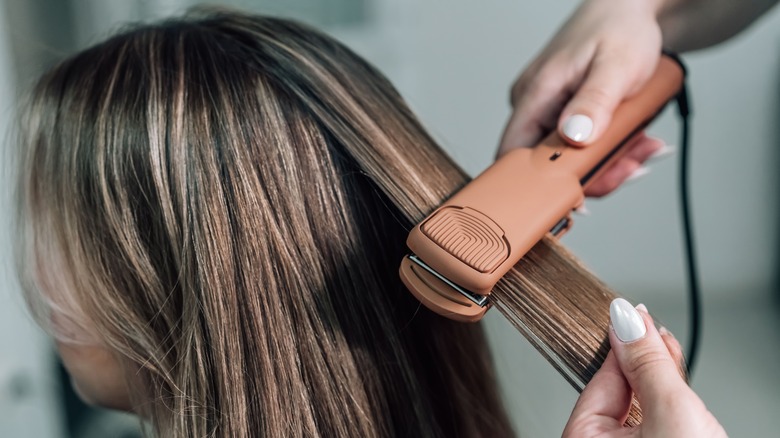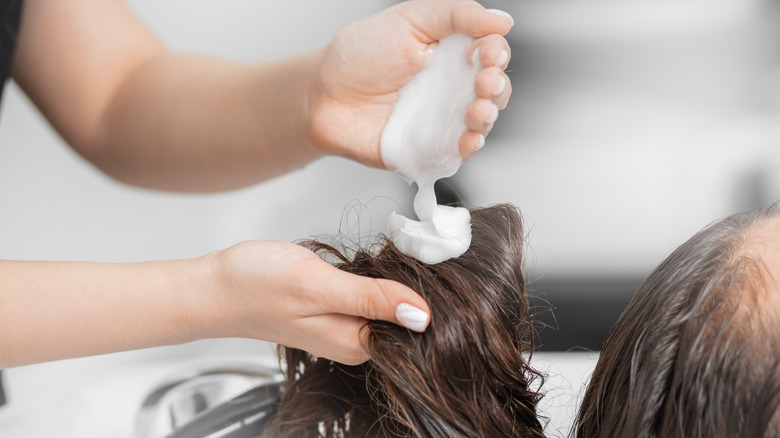Keratin Treatments Can Come With A Formaldehyde Risk. Here's How To Stay Safe
When it comes to hair straightening solutions, keratin treatments have been the preferred choice of many because they do more than just straighten. They can give you those luscious, shiny locks with added protection against breakage and split ends while repairing the damage from past chemical treatments. While all those benefits sound irresistible, there's a pretty major catch, and that lies in formaldehyde.
Formaldehyde is a notorious but effective chemical present in most keratin treatments. Speaking to Marie Claire, Meri Kate O'Connor, a hairstylist and colorist, explained how the treatment works, saying, "A traditional keratin treatment aims to straighten the hair and usually involves a formaldehyde-releasing solution." She added, "It basically coats your hair cuticle like armor." Essentially, the solution enables your hair to derive the benefits — and the formaldehyde.
It's no surprise that formaldehyde is released in many hair straightening and smoothening solutions. It plays a crucial part in the straightening process by helping the hair bonds break down and even helps reseal them in a new straight state that's smooth and frizz-free, per Harper's Bazaar. While you may be tempted to ignore its presence to reap its benefits, you should know that it poses several health hazards that might not make it worth the risk.
Why you should be wary of formaldehyde
Formaldehyde is certified as "known to be a human carcinogen" by the U.S. National Toxicology Program (NTP). According to Cancer.org, there have been multiple studies conducted to test the effect of formaldehyde in animals and humans. One study where rats were made to inhale formaldehyde gas found that it had the potential to cause nasal cancer (via Centres for Disease Control and Prevention). Another one where rats were made to drink water mixed with formaldehyde found an increase in intestinal and stomach tumors in the animal, per Cancer.org.
Human studies have been primarily conducted on people who faced prolonged exposure to formaldehyde at their workplace. Some studies have found a link between formaldehyde exposure and cancer of the nasopharynx. Another study found that people who have consistently been exposed to formaldehyde bear a greater risk of developing leukemia — more specifically, myeloid leukemia.
Although these studies look at the risks of long-term exposure to formaldehyde, it's not ideal to inhale it in shorter periods either. According to the National Cancer Institute, inhaling any more than 0.1 ppm of the chemical can cause "watery eyes, burning sensations in the eyes, nose, and throat, coughing, wheezing, nausea, and skin irritation." However, colorist specialist Brenda Kamt told Marie Claire that you can mitigate the risk of exposure during keratin treatment by choosing to get the procedure done only a few times per year in a well-ventilated salon or an open area.
Should you go for formaldehyde-free treatments instead?
Formaldehyde is a sneaky ingredient to spot because technically, it's not an ingredient but a by-product that's released during the keratin treatment process. So if you turn a hair product around and take a look at the composition, you will not find it listed as an ingredient. You'll instead find formaldehyde-releasing chemicals like methylene glycol, methanal, methanediol, and formalin.
While there are plenty of formaldehyde-free keratin treatments on the market, it might be best to take a different hair-straightening route altogether. As Katy Ryan, owner of Katy Ryan Studios, explained to Allure, "The ones promising straighter and longer-lasting results will no doubt have more formaldehyde." She added that the solution might also work for a different purpose: "If you want to maintain more body and curl, a formaldehyde-free formula might work best."
Furthermore, even if a formula claims to be formaldehyde-free, the chemical is still generated when the solution is mixed with water. It's a hard-to-escape chemical, but you can work with your stylist to figure out hair-straightening solutions that release the lowest possible amounts of formaldehyde or opt for temporary hair-straightening treatments. While temporary hair straighteners like flat irons can also cause damage to the hair, you're still avoiding the formaldehyde intake, so it might be worth the trade-off.


